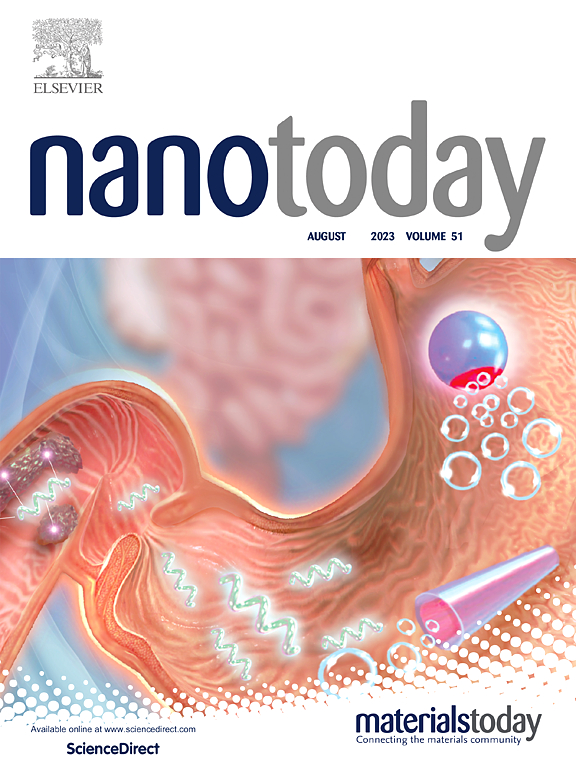利用环境高压电子显微镜-四极杆质谱仪分析Rh纳米颗粒表面在催化还原NO过程中的动态结构变化
IF 13.2
1区 材料科学
Q1 CHEMISTRY, MULTIDISCIPLINARY
引用次数: 0
摘要
传统的表征技术,如透射电子显微镜(TEM),无法在Rh纳米颗粒表面上观察到NO还原成N2过程中细微的结构变化。因此,在本研究中,我们利用环境反应科学高压电子显微镜和四极杆质谱仪(QMS)系统,对ZrO2负载的Rh纳米颗粒上NO还原过程进行了操作原子尺度的分析。这种创新的设置使我们能够观察到动态的表面结构变化,同时监测相关反应条件下N2的产生和NO的消耗。高分辨率TEM观测和基于QMS数据的动力学计算证实,在Rh纳米颗粒表面的不稳定氧化物单层内,金属铑和RhO2之间存在伪环过渡态,这是迄今为止未见的现象。将实验数据与模拟图像进行比较,揭示了在200-500℃、500-600℃和600-700℃三个不同温度范围内NO还原为N2的合理催化机制。在低温下,反应主要发生在纳米颗粒表面形成的薄薄的RhO2膜上,这与长期以来认为NO的还原发生在Rh金属位点的共识相悖。我们的方法能够直接观察到瞬态表面状态,并揭示了它们决定整个反应动力学的能力。本研究结果为实际条件下纳米颗粒表面催化反应的研究提供了新的思路,也为今后纳米颗粒表面催化机理的研究提供了指导。本文章由计算机程序翻译,如有差异,请以英文原文为准。
Operando analysis of dynamic structural changes on Rh nanoparticle surfaces during catalytic reduction of NO using an environmental high-voltage electron microscope–quadrupole mass spectrometer
Conventional characterization techniques such as transmission electron microscopy (TEM) cannot visualize the subtle structural changes in Rh nanoparticles during the reduction of NO to N2 on their surface. Hence, in this study, we used an environmental reaction science high-voltage electron microscope equipped with a quadrupole mass spectrometer (QMS) system to conduct operando atomic-scale analysis of the NO reduction process on Rh nanoparticles supported on ZrO2. This innovative setup enabled us to observe dynamic surface structural changes while simultaneously monitoring the production of N2 and consumption of NO under relevant reaction conditions. High-resolution TEM observations and kinetic calculations based on QMS data confirmed the presence of a pseudocyclic transitional state between Rh metallic and RhO2 within an unstable oxide monolayer on the surface of the Rh nanoparticles, which is a hitherto undocumented phenomenon. A comparison of experimental data with the corresponding simulated images revealed plausible catalytic mechanisms for the reduction of NO to N2 at three different temperature ranges (200–500, 500–600, and 600–700 °C). At low temperatures, the reaction primarily occurs on a thin RhO2 film formed on the nanoparticle surface, which defies the longstanding consensus that the reduction of NO occurs on Rh metal sites. Our methodology enabled the direct observation of transient surface states and revealed their ability to dictate the overall reaction dynamics. The findings of this study provide insights into surface catalytic reactions on nanoparticles under practical conditions as well as can guide future studies on catalytic mechanisms.
求助全文
通过发布文献求助,成功后即可免费获取论文全文。
去求助
来源期刊

Nano Today
工程技术-材料科学:综合
CiteScore
21.50
自引率
3.40%
发文量
305
审稿时长
40 days
期刊介绍:
Nano Today is a journal dedicated to publishing influential and innovative work in the field of nanoscience and technology. It covers a wide range of subject areas including biomaterials, materials chemistry, materials science, chemistry, bioengineering, biochemistry, genetics and molecular biology, engineering, and nanotechnology. The journal considers articles that inform readers about the latest research, breakthroughs, and topical issues in these fields. It provides comprehensive coverage through a mixture of peer-reviewed articles, research news, and information on key developments. Nano Today is abstracted and indexed in Science Citation Index, Ei Compendex, Embase, Scopus, and INSPEC.
 求助内容:
求助内容: 应助结果提醒方式:
应助结果提醒方式:


